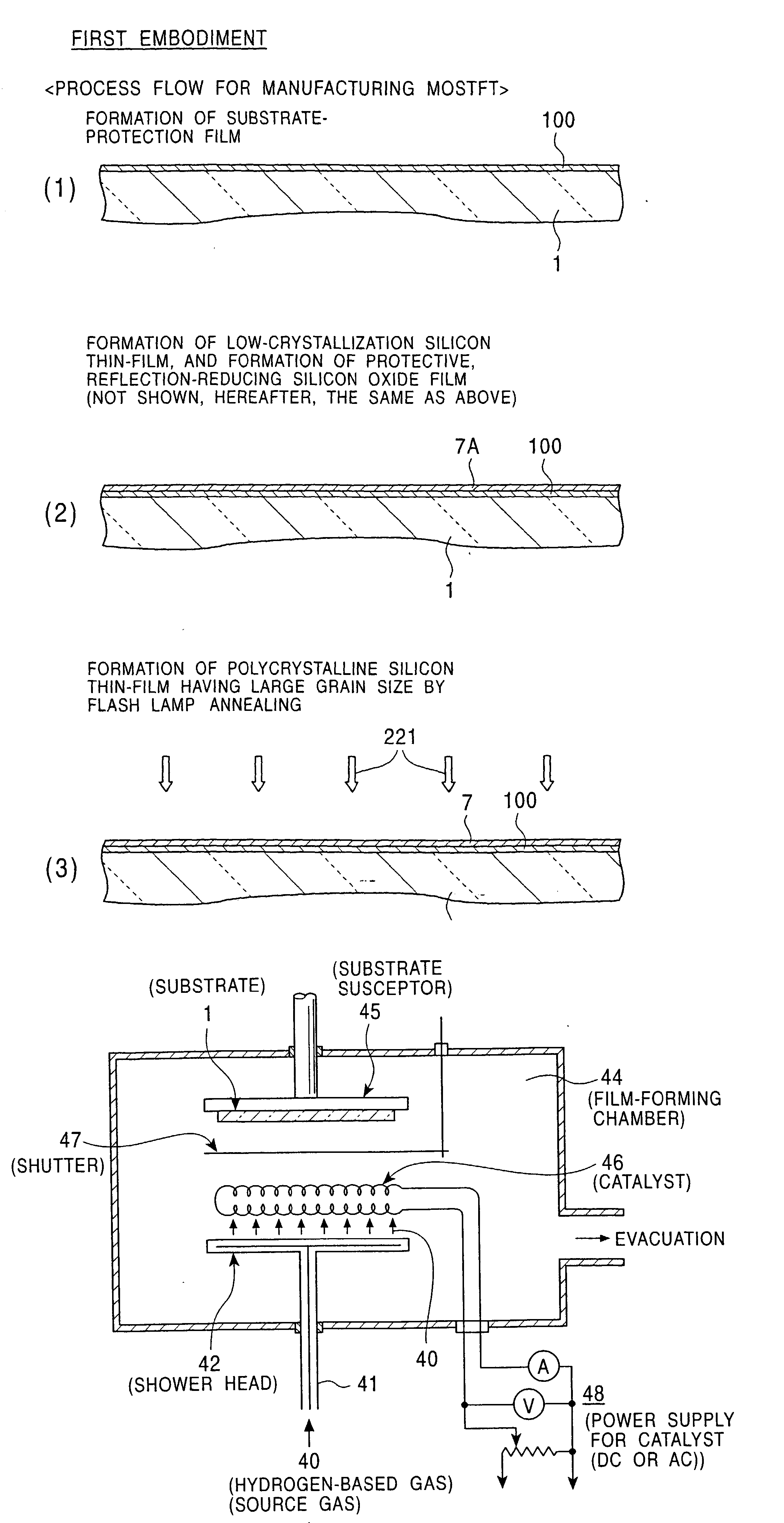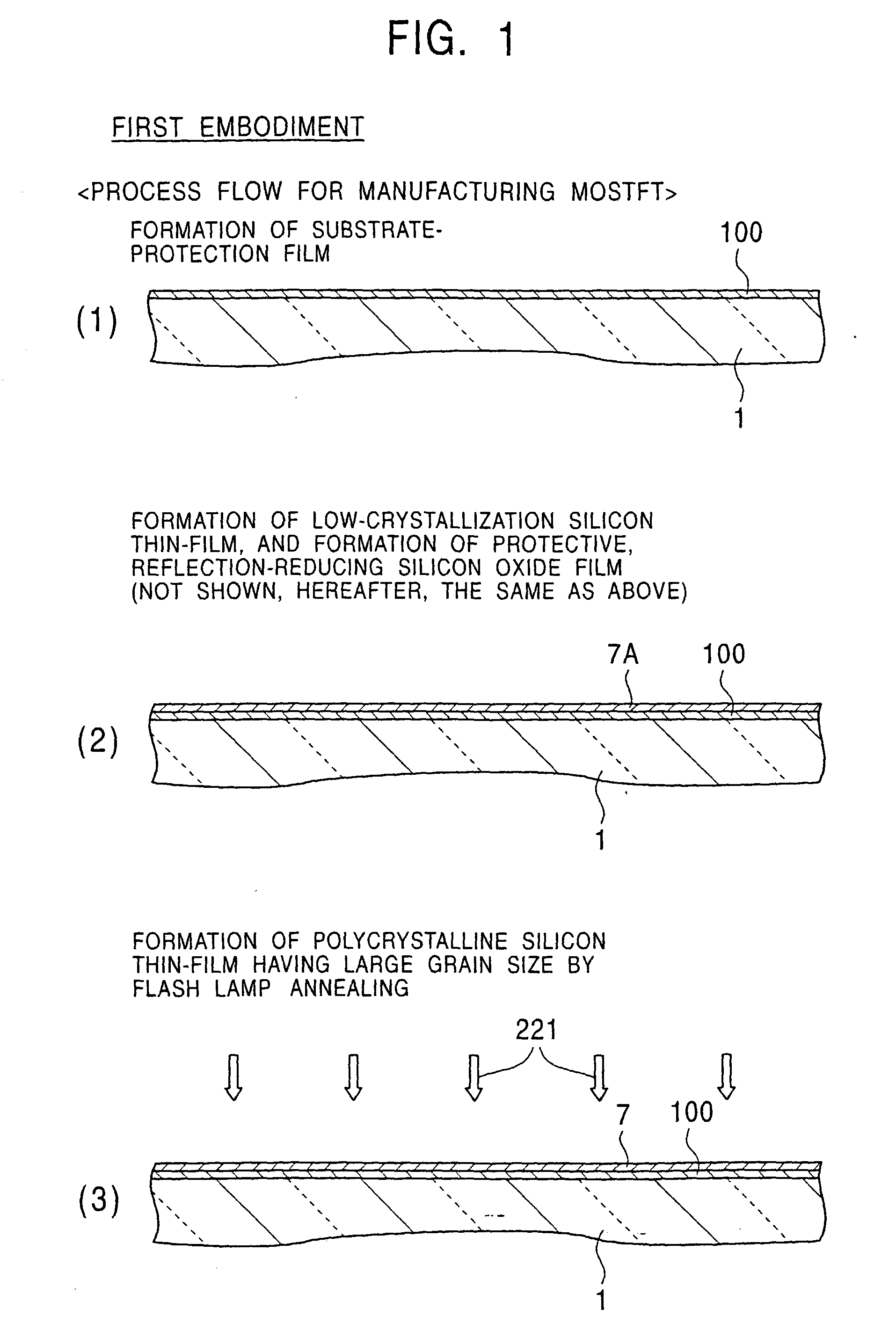Semiconductor thin film forming method, production methods for semiconductor device and electrooptical device, devices used for these methods, and semiconductor device and electrooptical device
a technology of semiconductor devices and thin films, applied in the direction of polycrystalline material growth, crystal growth process, chemically reactive gases, etc., can solve the problems of increasing the cost of apparatus, poor productivity, and difficulty in obtaining crystals with a grain size of 500 nm or mor
- Summary
- Abstract
- Description
- Claims
- Application Information
AI Technical Summary
Benefits of technology
Problems solved by technology
Method used
Image
Examples
fourth embodiment
[0607] Fourth Embodiment
[0608] In this embodiment, the present invention is applied to a field emission type (FED) display devices. Hereinafter, the structural examples and the manufacturing examples thereof will be described. In this embodiment, a top gate type MOSTFT will be described, and it is naturally understood that the present invention be applied to a bottom gate type or a dual gate type MOSTFT.
[0609]
[0610] As shown in FIGS. 50(A), (B), and (C), according to this structural example I, by using the polycrystalline silicon thin-film, which may or may not contain tin and which has a large grain size and high crystallinity, formed by the method described above according to the present invention on the substrate 111 composed of glass or the like, the gate channel regions 117, the source regions 120, and the drain regions 121 of the switching MOSTFT 1 and the current driving MOSTFT 2 are formed. In addition, the gate electrodes 115 are formed on the gate insulating film 118, and...
fifth embodiment
[0656] Fifth Embodiment
[0657] In this embodiment, the present invention is applied to a solar cell which is a photoelectric transfer device. A manufacturing example thereof will be described below.
[0658] First, as shown in FIG. 56(1), the n-type low-crystallization silicon film 7A (100 to 200 nm thick) is formed by plasma CVD, catalytic CVD, or the like on the metal substrate 111 formed of stainless steel or the like. In this case, an n-type dopant such as PH.sub.3 is appropriately contained in monosilane so as to have a concentration of 1.times.10.sup.19 to 1.times.10.sup.20 atoms / cc. In addition, when necessary, a thin-film (100 to 300 nm thick) of a high melting point metal (Ti, Ta, Mo, W, or an alloy thereof, such as a Mo--Ta alloy) or a metal silicide (WSi.sub.2, MoSi.sub.2, TiSi.sub.2, TaSi.sub.2, or the like) is formed on the metal substrate or a glass substrate by sputtering, CVD, or the like.
[0659] Continuously, by plasma CVD, catalytic CVD, or the like, an i-type low-cryst...
PUM
| Property | Measurement | Unit |
|---|---|---|
| emission time | aaaaa | aaaaa |
| emission time | aaaaa | aaaaa |
| pressure | aaaaa | aaaaa |
Abstract
Description
Claims
Application Information
 Login to View More
Login to View More - R&D
- Intellectual Property
- Life Sciences
- Materials
- Tech Scout
- Unparalleled Data Quality
- Higher Quality Content
- 60% Fewer Hallucinations
Browse by: Latest US Patents, China's latest patents, Technical Efficacy Thesaurus, Application Domain, Technology Topic, Popular Technical Reports.
© 2025 PatSnap. All rights reserved.Legal|Privacy policy|Modern Slavery Act Transparency Statement|Sitemap|About US| Contact US: help@patsnap.com



